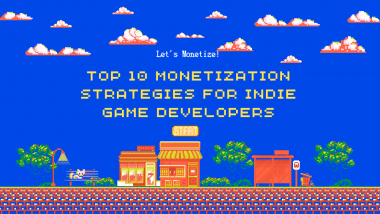Ever since Merge Mansion made waves across the internet sometime in 2020, merge games on smartphone platforms seem to have multiplied by orders of magnitude. There are dozens of them now, and yet the core mechanic that makes these games go – the “merging” – never seems to get old. Through a number of different techniques and visual presentations, that addicting nature has been leveraged into quite a lucrative monetization strategy as well.
Let’s talk about one merge game in particular – Merge Gardens – to see how it’s set up, how fun it is, and, more importantly, how it is monetized.
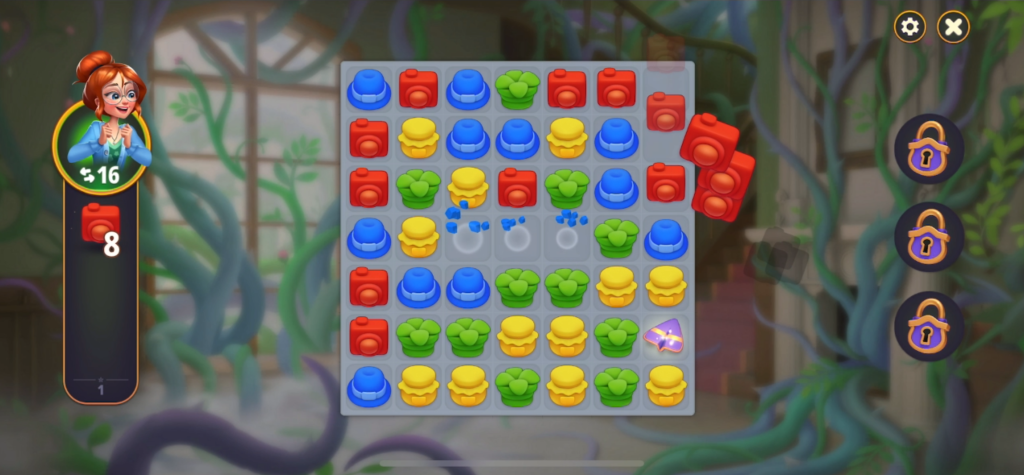
Planting the Seeds
Merge Gardens is developed and published by Futureplay Games – a Finnish game studio whose only other work is a Farmville clone called Idle Farming Empire. It seems that Merge Gardens has done well for them because they’ve been supporting it consistently over the past three-plus years, and the success of the game even caught the eye of a much, much bigger mobile game studio – Plarium.
The Raid: Shadow Legends maker acquired Futureplay back in 2021 as a means of breaking into the casual game sector, and that partnership appears to be serving both companies pretty well. In 2023 alone, Merge Gardens raked in more than $30 million in revenue with 5.4 million downloads. This puts it well behind Merge Mansion and Merge Dragons in terms of revenue, but that’s still definitely not something to ignore.
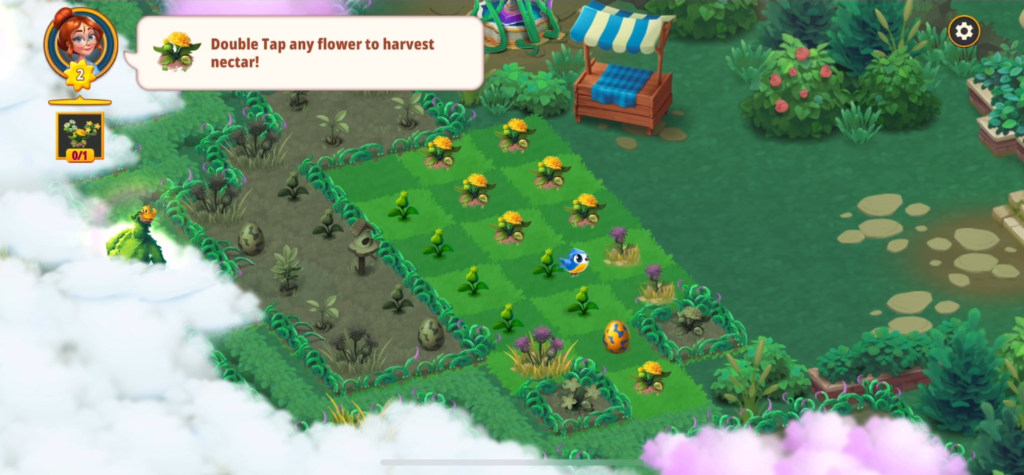
Welcome to Merge Gardens
Merge Gardens has all of the trappings of a good merge game.
Colorful, eye-catching graphics, simplified gameplay, and an underlying mystery that pulls players to keep coming back to the game. Overall, it’s a delight.
Gameplay is split between your standard merging gameplay in the ever-expanding garden area, and “exploring” the house it surrounds through a traditional match-3-style puzzle game. Those exploration sections also have mechanics that will be familiar to anyone who has played Bejeweled and other games like it – match-3 to clear, match-4 for a power-up, match-5 or more for an explosive tile, etc.
While these modes of gameplay are similar in function, Merge Gardens makes them look and feel different enough to break up the gameplay in a satisfying way. From my time with the game, I think that the “palate cleanser” of the house exploring puzzles are what kept me engaged for large chunks of time. Without them, I probably would have gotten tired of the primary gameplay faster and played in smaller sessions.
And, as we all know by now – the longer a player is engaged, the more likely they are to spend money in a mobile game. Let’s talk about Merge Garden’s monetization now.
Monetizing the Gardens
Merge Gardens has one of the shorter “Time to Store” periods that I’ve seen in recent memory. I’m not sure whether it had anything to do with my rate of progress or not, but I could access the store and begin making purchases after less than 10 minutes, and purchases were recommended to me shortly after that.
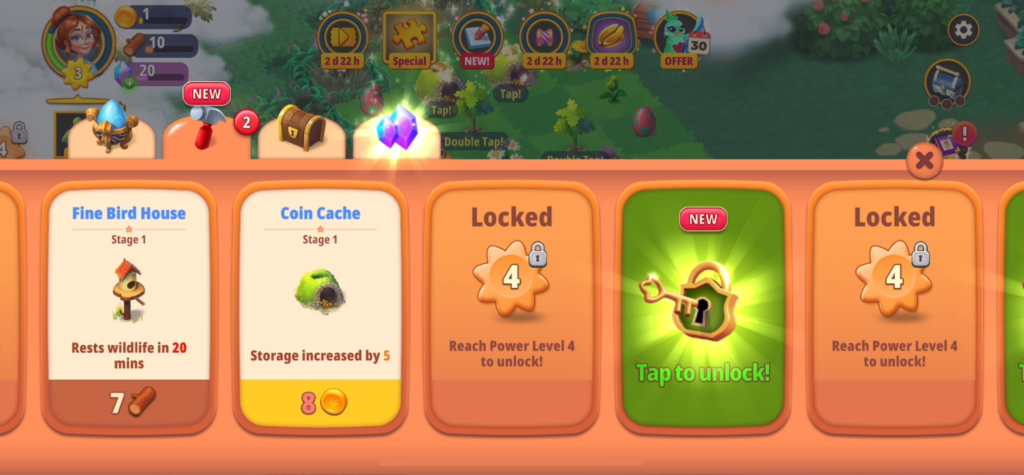
There are several ways that Merge Gardens monetizes its gameplay. To start, you can only directly purchase “gems”. Here is the breakdown of prices on gems within Merge Mansion:
120 gems – $4.99
270 gems – $9.99
600 gems – $19.99
2,000 gems – $49.99
4500 gems – $99.99
It’s worth noting that these packs of gems don’t just come with the gems themselves. Each package also includes extra helpful in-game items, which makes determining the value proposition of each a little murky. Further confusing the value proposition is the presence of packages that multiply a package’s gem offerings for the same price. For instance, the $99.99/4500 gems package is outclassed by a 7200 gems package also at $99.99. I would be curious to know how effective these packages are at driving sales of the more expensive offerings, although I wasn’t able to find that information anywhere.
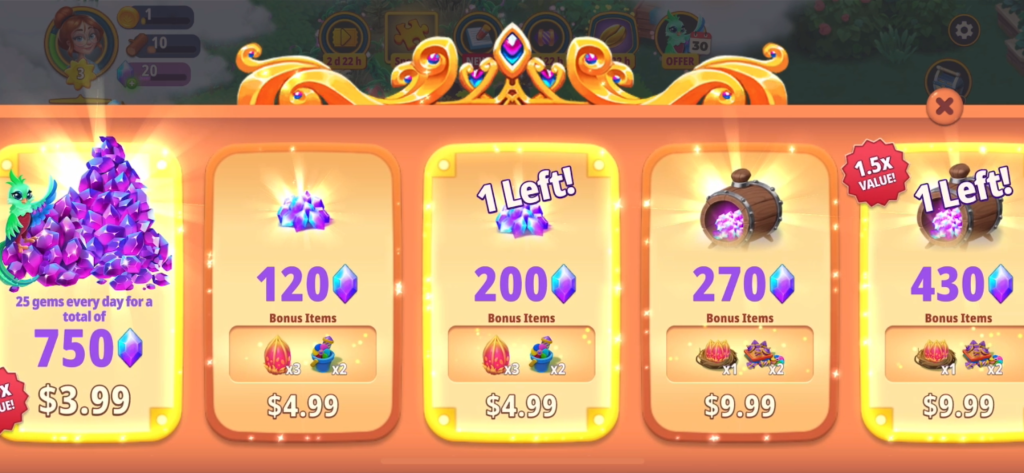
On top of all of that, there’s a subscription-type gem package that deals players 25 gems per day for 30 days – a total of 750 gems for just $3.99. This package appears to be designed to drive engagement over revenue, which is an interesting tactic for a game of this style.
Now, what exactly can you use those gems for?
Gems can be used for everything from making purchases in the store to bypassing timers on certain aspects of the game. For instance, you collect resources from the game tiles through the use of a bird character, but that bird character can only be active for a certain amount of time before it needs to “go to sleep” for 20 minutes. However, if you cough up 15 gems, the birds will feel energized enough to skip their nap.
Another interesting monetization tactic I encountered was an unusual real money offering. At one point in my playtime, all of the tiles in my play area were full, and I received a pop-up giving my attention to a “Veiled Garden” section that I could use to immediately expand my garden for a whopping $11.99. That seems a little steep to me even now after having played the game for a week or so, as it’s fairly easy to get around the limited tile space as long as you’re merging and organizing properly. But, for someone trying to get every little ounce of enjoyment out of the game, I can see how that offer might be enticing.
Merge Gardens is Here to Stay
Like other games in the segment, Merge Gardens weaponizes a potent combination of addictive gameplay and varied monetization tactics to create something that keeps both players and the companies that serve them very happy.
Again, it hasn’t proved to be as lucrative as Merge Mansion or Merge Dragons, but Merge Gardens also hasn’t benefited from a bizarre marketing campaign like Merge Mansion or the funding of a titan of the mobile game industry – like Merge Dragons is thanks to its developers’ partnership with Zynga.
With that in mind, Merge Gardens is still worth your time and money.
8/10






